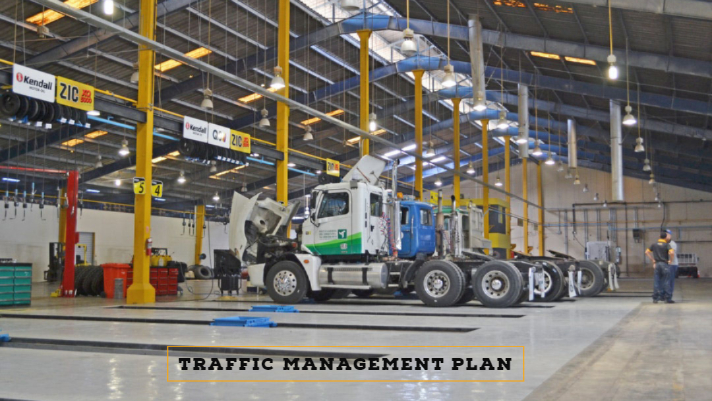A traffic management plan provides comprehensive information on managing the risks related to the vehicles such as a car, truck or forklift traffic in a workplace. The traffic management plan is required to be monitored and reviewed frequently in order to ensure traffic management plans are effective and reflects the changes in the workplace.
Depending on the size of the workplace, the vehicles are used and the frequency of the vehicles and pedestrians are interacting, workplaces are required to manage the risk of vehicles colliding with people.
In any workplace, the safety and well-being of employees should be a top priority. One critical aspect that often gets overlooked is traffic management within the work environment. A workplace traffic management plan is a comprehensive strategy designed to minimize the risk of accidents and ensure the smooth flow of vehicles and pedestrians. This article will discuss the importance of implementing a workplace traffic management plan and explore the key elements involved.
Understanding the importance of workplace traffic management
Workplace traffic management is crucial for several reasons. First and foremost, it helps prevent accidents and injuries. By implementing a traffic management plan, employers can identify potential hazards, such as blind spots or congested areas, and take appropriate measures to mitigate risks. This not only protects the employees but also reduces the likelihood of damage to property and equipment.
Moreover, a well-managed traffic system enhances productivity and efficiency. When vehicles and pedestrians can move freely and safely, it minimizes delays and disruptions. This ensures that tasks can be completed in a timely manner, leading to better overall performance and customer satisfaction.
Legal requirements for workplace traffic management plans
It is essential for employers to understand that workplace traffic management is not just a good practice but also a legal requirement in many jurisdictions. Government regulations and industry standards often mandate the implementation of traffic management plans, especially in high-risk industries such as construction, logistics, and manufacturing.
By complying with these legal requirements, employers demonstrate their commitment to the health and safety of their workforce. Failure to comply can result in severe penalties and legal consequences. Therefore, it is crucial to thoroughly understand and adhere to the specific regulations applicable to your industry and location.
Traffic Management Duties
Employers have a legal responsibility not to expose workers and others within the workplace, with health and safety risks. This involves the employer to:
- Identify the hazards and potential areas of collision between people and vehicles such as a car, truck or forklift.
- Consult and actively involve your team and others in the supply chain. Workers involvement in planning, developing, monitoring and reviewing traffic management plans, will identify the potential problems they are encountering at the workplace. This will assist the employer to identify the effective control measures.
- Implement the controls
- Review controls periodically.
Officers are required to exercise due diligence and ensure the business:
- have an understanding of health and safety, traffic management, risks workers and other people within the workplace are exposed to;
- have sufficient resources to manage traffic management;
- have policies, procedures to manage traffic management;
- implements the policies and procedures;
- complies with the health and safety act.
Workers responsibilities are to take reasonable care for their health and safety, co-operate with reasonable workplace policies and procedures, comply, and not adversely affect other people’s health and safety.
Examples are: Workers are required to understand the companies traffic management process, attend training, participate in consultation, follow the traffic management policies, and procedures, don’t expose themselves and others in risk.
Managers responsibilities are to ensure anything entering the workplace is without risk to health and safety.
Some of the examples are: a manager can make sure traffic management plans are communicated, consulted, implemented. Workers are supervised.
Designers, manufacturers, suppliers and importers of plant and structures are required to ensure that their plant and structures are without risk to health and safety.
Benefits of implementing a workplace traffic management plan
Implementing a workplace traffic management plan offers numerous benefits beyond legal compliance. Firstly, it significantly reduces the chances of accidents and injuries. By identifying potential hazards and implementing appropriate control measures, employers create a safer work environment for all.
Secondly, a well-managed traffic system enhances operational efficiency. Employees can move around the workplace more quickly, which helps streamline workflows and increase productivity. Additionally, a smooth traffic flow reduces congestion, allowing for faster loading and unloading of goods and materials.
Furthermore, a workplace traffic management plan improves employee morale and satisfaction. When employees feel safe and supported, they are more likely to be engaged and motivated. This, in turn, leads to higher levels of job satisfaction and lower turnover rates.
Key elements of a workplace traffic management plan
A workplace traffic management plan should encompass several key elements to be effective. Firstly, it should identify potential hazards and assess their associated risks. This includes evaluating traffic flow patterns, identifying blind spots, and considering the interaction between vehicles and pedestrians.
Once the hazards are identified, appropriate control measures should be implemented. This may include installing clear signage, creating designated pedestrian walkways, implementing speed limits, and using physical barriers to separate vehicles and pedestrians.
Regular monitoring and review are also crucial components of a traffic management plan. This allows employers to identify any shortcomings or areas for improvement and make the necessary adjustments accordingly. Additionally, ongoing training and education should be provided to employees to ensure they are aware of the plan and understand their roles and responsibilities within it.
How to develop a workplace traffic management plan
Developing an effective workplace traffic management plan requires careful consideration and collaboration. The first step is to conduct a thorough assessment of the work environment and identify potential hazards. This can be done through site inspections, data analysis, and consultation with employees.
Once the hazards are identified, control measures should be determined and implemented. This may involve modifying the layout of the workplace, installing safety features, and establishing clear procedures for vehicle and pedestrian movement.
Regular communication and consultation with employees are essential throughout the development process. Their input and feedback can provide valuable insights and help ensure that the plan is practical and effective. It is also important to document the plan and make it easily accessible to all employees.
Training and education for workplace traffic management
Implementing a workplace traffic management plan is not enough; proper training and education are equally important. All employees should receive comprehensive training on the plan’s content, including the identified hazards, control measures, and their individual responsibilities.
Training sessions should be conducted regularly to ensure that new employees are properly informed and existing employees receive refresher courses. Additionally, ongoing education and awareness programs can help reinforce safe behaviors and promote a culture of safety throughout the organization.
Tips for effective implementation and enforcement
To ensure the successful implementation and enforcement of a workplace traffic management plan, employers can follow several tips. Firstly, strong leadership and commitment from management are essential. When leaders prioritize safety and actively support the plan, employees are more likely to take it seriously.
Regular communication and engagement with employees also play a crucial role. Employers should provide clear instructions, guidelines, and feedback to ensure that everyone understands and follows the plan. Additionally, supervisors and managers should lead by example and consistently enforce the plan’s rules and regulations.
Regular audits and inspections can help identify any deviations or areas that require improvement. These findings should be promptly addressed, and corrective actions should be taken to maintain the effectiveness of the traffic management plan.
Conclusion and final thoughts
In conclusion, implementing a workplace traffic management plan is of paramount importance for organizations seeking to prioritize employee safety and well-being. By identifying potential hazards, implementing control measures, and providing proper training, employers can significantly reduce the risk of accidents and injuries. Moreover, a well-managed traffic system enhances productivity, efficiency, and employee satisfaction.
Remember, workplace traffic management is not just a legal requirement but a moral obligation to protect those who work for you. By prioritizing the development and implementation of a comprehensive traffic management plan, you are taking a proactive step towards creating a safe and productive work environment. So, invest the time and resources necessary
Access Work Health and Safety Books from Amazon: Work Health and Safety
WHS and Training Compliance Solutions, offer WHS training courses across Australia. We have online, onsite, elearning and public WHS courses. Contact us for more information.















